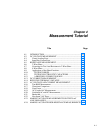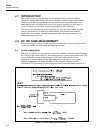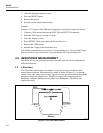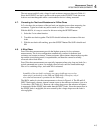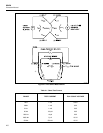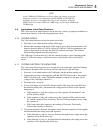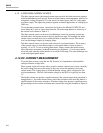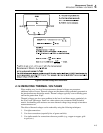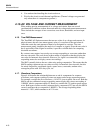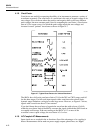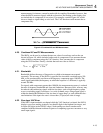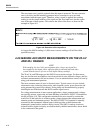
Measurement Tutorial
RESISTANCE MEASUREMENT
4
4-7
NOTE
In the 2 M
Ω
and 20 M
Ω
ranges of 4-wire ohms, the voltage across the
unknown resistance is sensed between the HI SENSE and LO INPUT
terminals. Accuracy is not affected as long as the resistance of the LO
INPUT lead is less than 10
Ω
in the 2 M
Ω
range, and less than 100
Ω
in the
20 M
Ω
range.
4-9. Applications of the Ohms Functions
The 2-wire and 4-wire ohms functions can be used for a variety of purposes in addition to
measuring resistance, as the following applications show.
4-10. TESTING DIODES
The 2-wire ohms function can also be used to test diodes.
1. Select the 2-wire ohms function and the 2 kΩ range.
2. Measure the resistance of the diode. If the diode is good, when forward-biased it will
measure about 0.6 kΩ to 0.7 kΩ for silicon (0.25 kΩ to 0.3 kΩ for germanium), and
when reverse-biased it will cause the 8842A to indicate overrange. (The forward-
biased reading depends upon the range used.)
The 2 kΩ range is used because its 1 mA test current provides a typical operating point,
and its 2V full-scale voltage is sufficient to turn on most diodes (even two diodes in
series).
4-11. TESTING ELECTROLYTIC CAPACITORS
The 2-wire ohms function can also give a rough test of an electrolytic capacitor’s leakage
and dielectric absorption. This test works well for capacitors 0.5 µF and larger.
1. Select the 2-wire ohms function, the 2 kΩ range, and the medium reading rate.
2. Connect the test leads to the capacitor (with the INPUT HI lead to the + lead and the
INPUT LO lead to the - lead). The 8842A attempts to charge it to the open-circuit
voltage of the 2 kΩ range (about 6V).
3. Disconnect the + test lead.
4. To test for leakage, select the VDC function and the 20V range (leave the 8842A in
the medium reading rate), and measure the voltage that was stored on the capacitor
during step 2.
a. If the capacitor is good, the voltage across the capacitor will be about 6V, and
will be relatively stable.
b. If the capacitor is leaky, the voltage across the capacitor will be much less than
6V, and the voltage will be decreasing. The rate of change depends on how leaky
the capacitor is.
c. With some electrolytic capacitors, the reading will increase. This usually
indicates the capacitor is defective.
5. To test the capacitor’s dielectric absorption, briefly short the capacitor’s leads together
and then measure the voltage across the capacitor.
a. If the dielectric is good (i.e., has low dielectric absorption), the voltage across the
capacitor will be nearly zero volts.
b. If the dielectric is poor (i.e., has high dielectric absorption), the voltage across the
capacitor will be significantly above zero.





